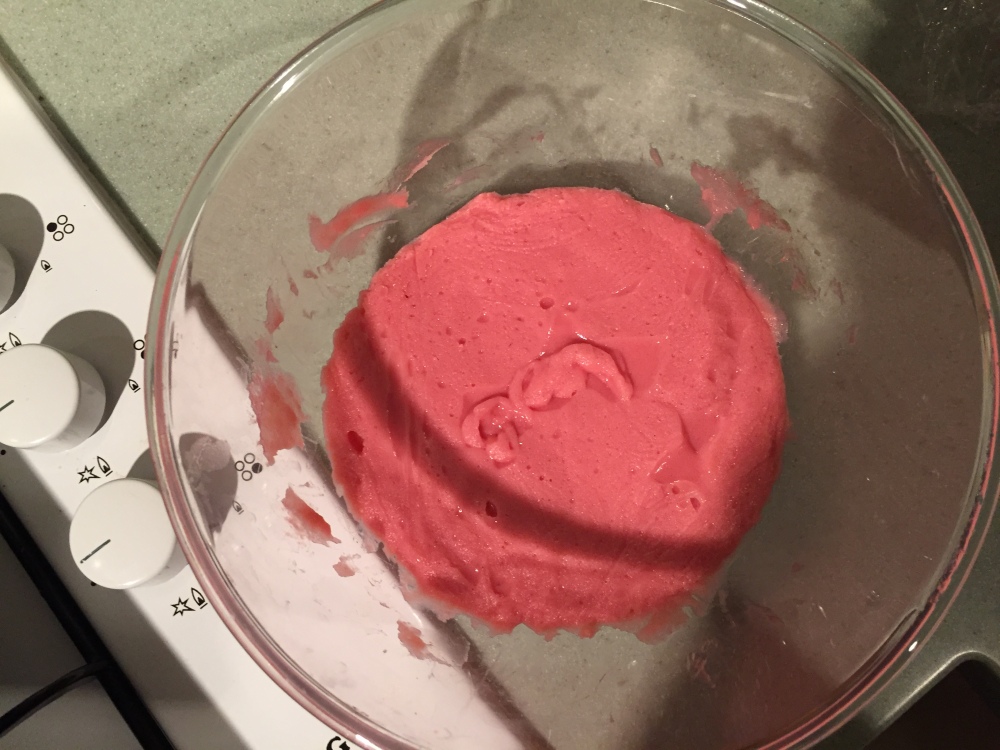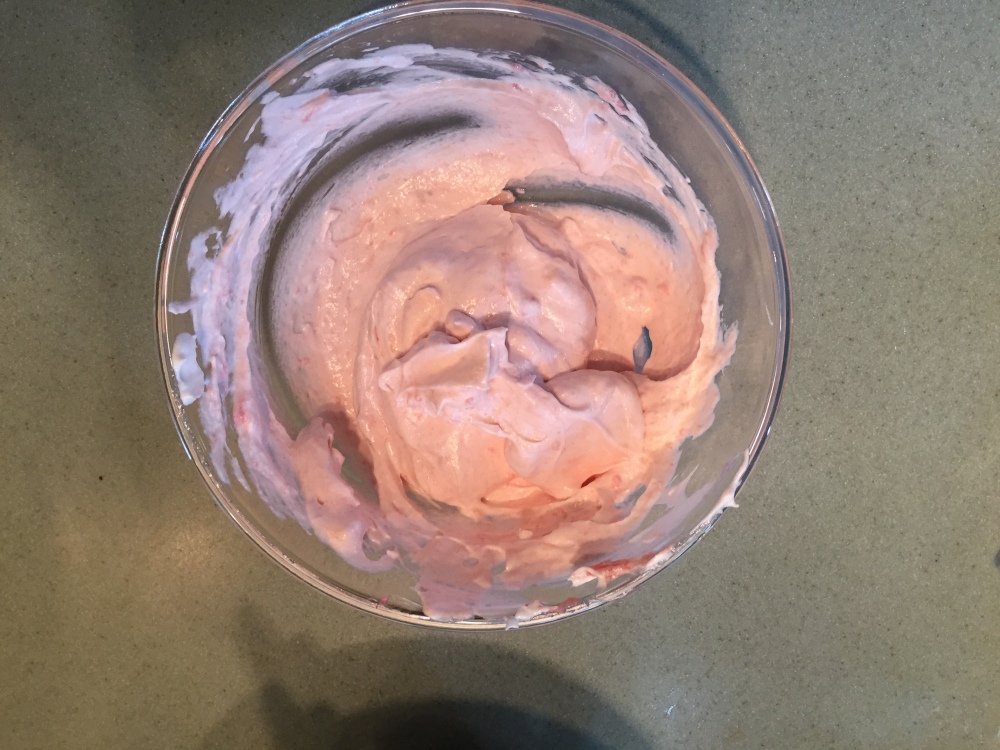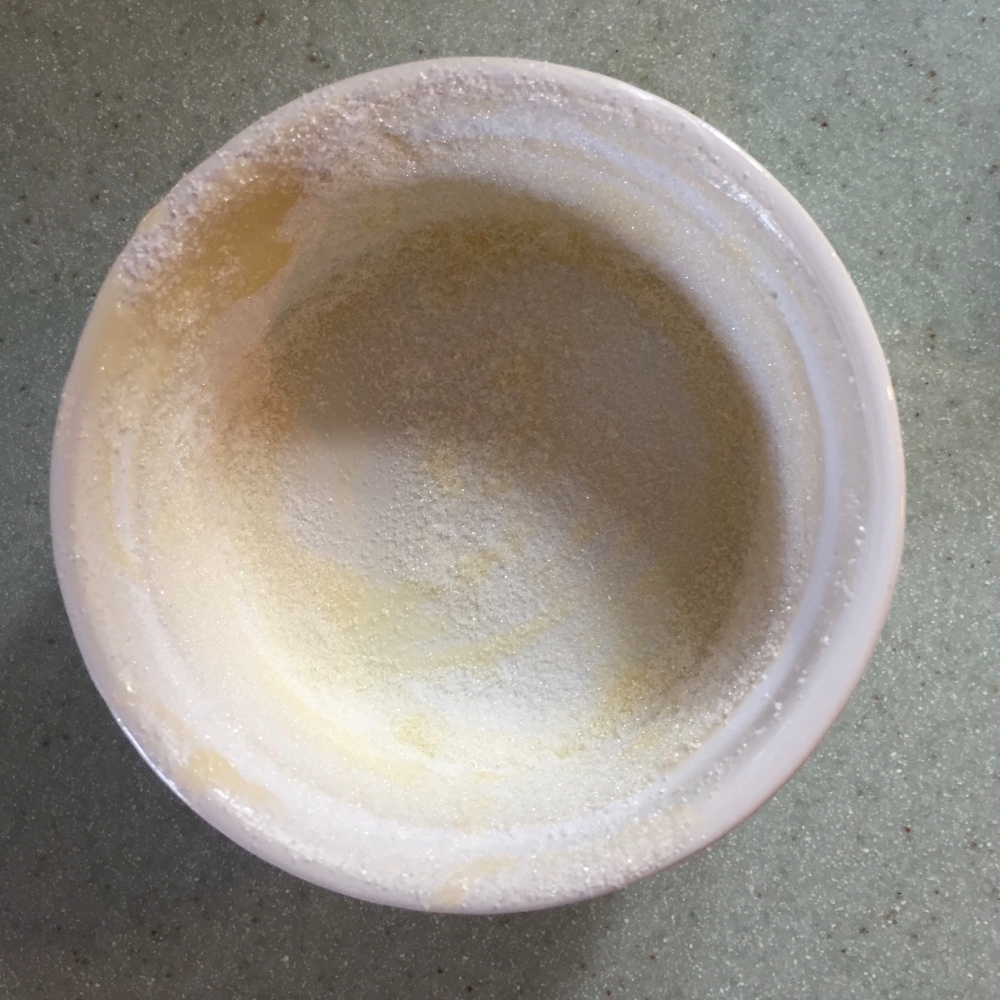The annual minuscule crop of Gooseberries was harvested a month ago and it is never enough to make jam with. I have 2 gooseberry bushes and this year one of them decided not to fruit at all (or the birds had them all) so I was left with about 700g of red gooseberries ripening at different speeds slowly being added to a container in the freezer. Last year I did a cake, but this year I was determined to finally recreate the Gooseberry Soufflé we had at a meal in Boundary (a lovely restaurant in London) that still sticks in the mind.

Soufflé has a fearsome reputation and I have not really done one since the 70’s when my youth and the fashion for Cheese Soufflé obviously made me much bolder. In restaurants there is always that fearsome message of allowing 20 minutes for your pudding when ordering one,. When entertaining at home, the need to disappear into the kitchen for 20 minutes never really appeals, especially at the end of the meal when far too much grape juice has been drunk. I like to think though that I am made of sterner stuff, plus I really wanted to finally do this pudding.
My first challenge was to find a recipe. Gooseberry and Elderflower as a combination came up very early on, but finding a recipe specific to Gooseberry Soufflé proved I was in esoteric territory. So it was back to first principles requiring quite a lot of googling on fruit based Soufflés which has proved enlightening, and assured me that these are not such tricky devils as everyone fears.
So firstly let’s explode the first fear. Soufflé is not difficult. It is basically a meringue mix (egg white and sugar) folded into a Bechemel (white) sauce or a Creme Patissiere base, along with other ingredients to provide flavour. For sweet ones this is usually a fruit puree. For savoury ones it is mostly cheese. So if you know how to do those 3 individual things, soufflé really does not represent a huge challenge.

My biggest problem however was the fruit puree. How was I going to turn my gooseberries into puree? The google was not that enlightening and the fruit is quite tough skinned, holds a lot of liquid and has a lot of seeds They therefore do not lend themselves to pressing through a sieve raw like other soft fruits, so they have to be heated and then pressed through the sieve afterward. The result of this process is more a juice than puree, and my biggest concern when I discovered this was that adding this to my creme patissiere base would make the mixture too wet which my reading said would get in the way of the souffles rising.

Frankly not a single website gave me the solution to this one, and I thought I was going to have to give up on my idea. I am however a determined soul who does not give up easily and once challenged will not let a problem go until I have found an answer. It is a trait that has led to many a sleepless night, but I have to say this is the first time I have lost sleep over a soufflé base. Ironically the answer, as it so often does, actually came in my sleep.
The Germans do a version of Buttercream (similar to Creme Mousseline) which uses fruit juice rather than milk for the Creme Patissiere recipe. Having tried it once, I know that for this to be successful it needs to be a fruit juice with a strong flavour which gooseberries certainly are. This I figured was the answer – replace the milk with my Gooseberry Juice, up the quantity to allow for the lack of puree. The result was a strongly gooseberry flavoured base in this very alarming pink and I think a technique for making a fruit flavoured soufflé I have not seen elsewhere.

That solved, I was then onto the next challenge – will it rise and look like those lovely columns rising from a porcelain ramekin that you see in restaurants ? On that one you really should have less fear than you probably have. As long as your bechemel/creme pat base is not too wet and you don’t knock the air out of the whipped egg white meringue mix when combining with the base, they will rise. That air in the egg white is trapped inside the mixture and it wants to rise to the heavens as it gets hotter, taking your soufflé with it. You need to help them along with buttered dishes sprinkled with sugar, and cutting round the rim, but rise they will.
It is however this vital part of the recipe which means you can’t really make the mix in advance. The longer the whipped egg sits uncooked in the mix, the more air will be absorbed back into the mix limiting the potential of the rise. Other precautions I have seen are not having your meringue mixture over stiff, but I have seen in my internet travels recipes which say the opposite. I have even seen a suggestion that you make Italian meringue whose greater stability does mean you can pre make the mix before you sit down to dinner – one to experiment with another time.

These items sorted, I must now address the final fear. The fear of collapse. The cause of an immediate collapse is just like a cake: if they are not cooked through they will drop. Judging that moment however is not one you can test like a cake – once out of the oven and falling you can’t rescue them!. All I can say is that soufflés go through a sudden acceleration in the rise towards the end of the bake, and being golden brown on the edges is a good sign. My only advice is to err on the side of caution but don’t overcook unless you want baked custard tarts. My ones stayed risen all the time, but in my first batch a few collapsed whilst their brothers and sisters were fine.
So what other tips do I have?
- whisk the cream pat up before combining the egg white to break it up and make it smooth – especially if it has had time to set
- stir in a quarter of your egg whites to lighten the mixture before folding in the rest
- fill the ramekins to the top and then scrape across with a palette knife – this way you get those smooth tops you see in restaurants
- wipe the ramekins after filling to avoid unsightly bits on the side when you serve them
- fill the ramekins to the top and scrape across the top with a palette knife so they are absolutely flat – that’s how you get that restaurant flat top look rather than a cracked surface
- run a knife around the edge of the mix after filling to help free the mixture so it can start rising sooner
And of all the articles I read – here is the best one from the Daily Telegraph in 2007. by Xanthe Clay. This along with a quick read of our Gastronomique by Larousse resolved most of my questions.
And of course to cap it off, there is only one way to serve this….with a delicious scoop of homemade ice cream plopped into the top. In my case that is homemade Elderflower Ice Cream which may make it on to the blog soon.

The Recipe
Ingredients
- 350g gooseberry juice (made from c. 700g gooseberries)
- 5 medium eggs (separated)
- 70g sugar for the creme pat (4 tbsp)
- 70g sugar for the meringue
- 2 1/2 tbsp cornflour
- a vanilla pod
- 6 ramekins
- butter and sugar for greasing the ramekins

For the Gooseberry Puree
- ideally freeze the gooseberries first as this breaks them down a bit before the next stage
- put the gooseberries in a pan and heat until they break down and become pulpy
- press through a sieve to remove all the pips
- set aside
To prepare the Ramekins
- melt a small amount of butter and brush the ramekins with it
- put the ramekins in the fridge until the butter is set
- brush on another layer of butter
- put a spoonful of sugar in the ramekins to and tip and tilt until the sides are lined with sugar
- set aside for later

For the Creme Pat
- measure out the gooseberry juice and the seeds of the vanilla pod and heat to just boiling and then remove from the heat
- whisk together the egg yolks, sugar and cornflour together until the mixture is a pale yellow
- add a a spoonful of the juice to the egg and stir together and continue a bit at a time until combined (you do this to stop the mixture curdling)
- put back on the heat and bring to the boil and simmer (well plop) for a few minutes whisking all the time
- press through a sieve
- cover with cling film (with the film touching the mixture to prevent a skin forming)
The Last Stage
All the other stages can be done well before you are ready to serve the soufflés. This one has to wait until you are ready to serve them – that 20 minutes when ordering a soufflé in a restaurant is there for a reason!
- heat the oven to 200C / 180 C fan
- whisk the creme pat briefly until smooth (it helps avoid lumps and eases the folding in of the egg whites minimising the loss of air)
- whisk the egg whites until stiff
- continue whisking and add the sugar a spoonful at a time until the mixture is white and glossy and forms soft peaks
- fold the egg whites into the creme pat being careful not to knock out the air
- fill the ramekins and scrape across the top with a palette knife
- wipe the edges clean
- score around the edge (this helps release the souffles for their rise)
- bake in the oven for 10 to 15 minutes until golden and risen
- serve immediately – preferably with ice cream

















Only cooked with gooseberries a couple of times, but this is a fabulous way to prepare them. Your souffle’s look perfect as well (:
LikeLike
Thank you – it is delicious because the acidity of the gooseberries offsets the sweetness perfectly
LikeLiked by 1 person
Your soufflés look incredible. I’ve always been too intimidated to give them a shot… you may have inspired me to try, though 🙂 !!
LikeLike
Do – if you can do meringue you can do these !
LikeLiked by 1 person
Hi, Just to say that I followed your recipe and it turned out brilliantly. I’ve had variable results previously with souffles, which have become something of a family obsession over lock down, mainly due a fixation that our son (who has autism) has with them. We’d already tried lemon, rhubarb and hot chocolate, but I’m pleased to say that your excellent recipe has given us the best results by far. We just used standard green gooseberries from out local pick your own, but the flavour combination was excellent. The kids are demanding that this becomes a weekly fixture, so I think that I’ll be stocking up on gooseberries whilst they are in season and freezing them down. Thanks so much for sharing the recipe!
LikeLike
I am so pleased. This might inspire me back to blogging …. and baking. My lockdown sadly meant vast amounts of work with little time for anything else.
The recipe is adaptable with any other fruit purée. I buy mine online and they can be used for mousses and ice cream too. BlackBerry cassis is particularly good…..
And I noticed gooseberries in our local farm shop so I might follow your example.
LikeLike